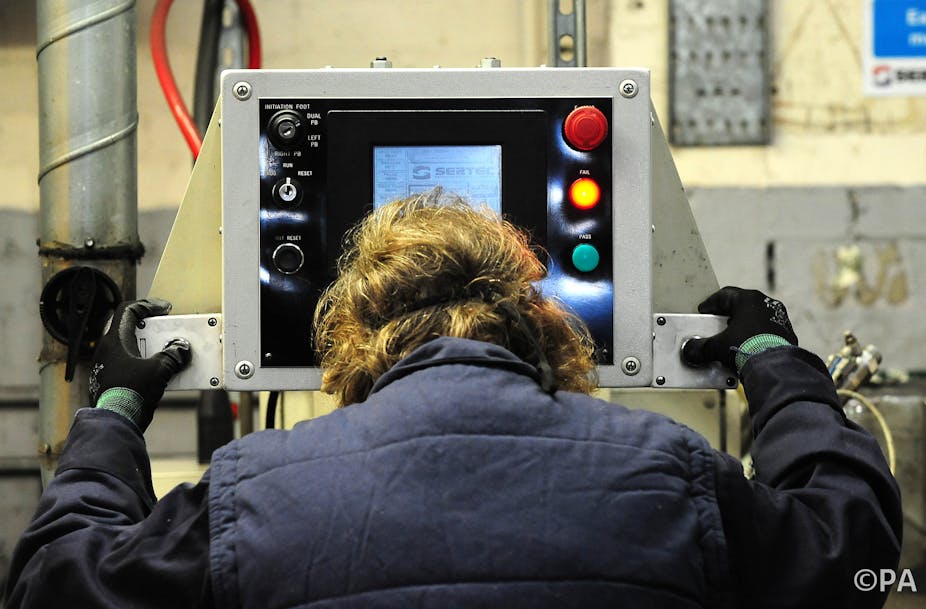Something strange, or perhaps rather unexpected, has occurred over the past few years: the media and politicians alike have been highlighting the strength of British manufacturing. Stranger yet, perhaps, are the many accounts of high profile manufacturing firms that have returned production processes to the UK from low-cost production locations abroad.
Since the 1970s, British newspapers have heralded the decline of British manufacturing. They charted the closure of companies as manufacturing production shifted from the UK to more cost-efficient plants elsewhere. A new global geography of manufacturing was emerging. Evidently the UK’s role in the developing global economy was not going to be as the “workshop of the world”, but rather as a global centre for the production of complex financial products.
The difficulty is that British firms continued to produce manufactured goods. Tales of the demise of British manufacturing failed to appreciate that it was not declining in the UK, but was rather undergoing major transformations. Firms were restructuring away from competition based on price to competition founded upon knowledge, innovation, quality, reputation, brand and speed of response.
This transformation is not associated with a substantial increase in employment in manufacturing firms, but there is related employment in service firms that support manufacturing activities. Nevertheless, this is a story about manufacturing success and is also one about the importance of manufacturing for British exports.
If we build it, they will come
Perhaps the key question is: how do we explain the return of manufacturing production to the UK? This appears to be a less than sensible business strategy. This trend can be traced back to 2009 when a survey of 300 manufacturing firms located in the UK found that in the previous two years, 14% of those firms had brought production back onshore. In 2013 a report produced by the Manufacturing Advisory Service noted that 15% of companies were returning production to the UK. This is a process of “onshoring”, “reshoring”, or the repatriation of production work back to the UK. For the UK this process of manufacturing onshoring is perhaps best described as a trickle rather than a flood.
Three processes can be identified. First, there is the repatriation of production from low-cost locations. Second, companies are investing in onshore production capability that enhances capacity; and third, companies that were sourcing components from overseas are switching to local producers. The reasons why manufacturing is coming back to the UK are the same reasons why –- for many successful manufacturers –- it never strayed abroad.
There are seven reasons manufacturing production is coming back to the UK:
Firms are shifting production onshore, as offshore cost savings were not as great as anticipated. Labour increasingly accounts for a small proportion of a product’s manufacturing costs. This means that, for many products, wage inflation combined with escalating shipping costs will reduce the savings gained from outsourcing to locations such as China.
The production of products outside the home market can lead to long product-delivery cycles; speed and closeness to market are becoming significant drivers of success.
There have been concerns with the quality of products supplied by producers located in low-cost locations.
There have been problems related to the loss of intellectual property.
Firms are reluctant to tie up valuable capital in large overseas shipments. Managers have begun to seek alternative local suppliers willing to supply small batches.
Companies are beginning to appreciate the benefits of co-locating design and development with production managers and assembly workers. This enables a close dialogue between design, development and manufacturing.
During the 20th century, labour played an important role in where goods were manufactured. This century, energy will play a much more important role and may displace labour costs as the most important factor. Energy costs are involved in the shipment of products from low-cost locations to the UK and also in fabrication.
We are living in very exciting times. At the start of this century, the return of manufacturing to the UK was more fantasy than reality. Over the next ten years this nation’s economy will be transformed as the ongoing revolution in manufacturing processes continues.
There are problems to be addressed. The British government needs to address the availability and cost of energy. The current debate on energy revolves around homes, but perhaps the more critical conversation should be about energy and production. Skills shortages and hard-to-fill vacancies are a constant problem for British firms: manufacturing must once again become a career option considered by all students. Manufacturing within the UK needs to undergo a process of rebranding. The British government must develop a long-term policy designed to support the ongoing transformation of British manufacturing so more firms can return home.

